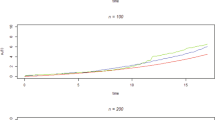Abstract
Recurrent event data are often encountered in longitudinal studies and in many other important areas such as Biomedical science, Econometrics, Reliability, Criminology and so on. Several marginal rates models have been used extensively to analyze recurrent event data, but often fail to fit the data adequately. In addition, the analysis is complicated by excess zeros in data as well as the presence of a terminal event. Furthermore effect of competing risks in recurrent event data analyze is rarely investigated. A semiparametric model with additive rate function is introduced in this paper in which unspecified baseline is applied to analyze recurrent event data with zero-recurrence and terminal event. Moreover multiple specified hazard function is used for analysis of competing risks, which includes a parameter to accommodate excess zeros and a frailty term to take into account for a terminal event. Taylor expansion is used to decompose baseline hazard function for each competing risk separately, and local likelihood procedure is applied to estimate parameters. Finally, a simulation study is presented for two specified baseline hazard functions with two different competing risks which approve the performance of presented model against existing models. An illustrative application based on a real bone marrow transplantation data is prepared.



Similar content being viewed by others
References
Andersen, P. and Gill, R. (1982). Cox’s regression model for counting processes : a large sample study. Annals of Statistics 10, 1100–1120.
Chen, D., Yu, L., Peace, K., Lio, Y. and Wang, Y. (2013). Approximating the Baseline Hazard Function by Taylor Series for Interval-Censored Time-to-Event Data. Journal of Biopharmaceutical Statistics 23, 695–708.
Clayton, D. (1987). A model for Association in bi-Variate Life Tables and its Application in Epidemiological Studies of Familiar Tendency in Chronic Disease Incidence. Biometrika 65, 141–151.
Dauxois, J. and Sencey, S. (2009). Non-parametric Tests for Recurrent Events under Competing Risks. Scandinavian Journal of Statistics 36, 649–670.
Ghaffari, H., Alimoghaddam, K, Foroughi, F., Chahardouli, B., Sanaat, Z., Bahar, B., Mousavi, A., Iravani, M. and Ghavamzadeh, A. (2005). Effects of Chimerism on Graft-Versus-Host Disease, Disease Recurrence and Survival After HLA-Identical Marrow Transplantation in Iran. Blood Journal of Iran 2, No 5.
Ghosh, D. and Lin, D. (2000). Nonparametric Analysis of Recurrent Events and Death. Biometrics 56, 554–562.
Huang, C. and Wang, M. (2004). Joint Modeling and Estimation For Recurrent Event Processes and Failure Time Data. Journal of the American Statistical Association 98, 663–670.
Lawless, J. and Nadeau, C. (1995). Some Simple Robust Methods For The Analysis of Recurrent Events. Technometrics 37, 158–168.
Lin, D., Wei, L., Yang, I. and Ying, Z. (2000). Semiparametric Regression For The Mean And Rate Functions Of Recurrent Events. Journal of the Royal Statistical Society B 62, 711–730.
Luo, X., Wang, M. and Huang, C. (2008). A Comparison Of Various Rate Functions Of A Recurrent Event Process In The Presence Of A Terminal Event. Statistical Methods in Medical Research 17, 207–221.
McDonald, J. and Rosina, A. (2001). Mixture Modelling Of Recurrent Event Times With Long-Term Survivors : Analysis Of Hutterite Birth Intervals. Statistical Methods and Applications 10, 257–272.
Nelson, W. (1995). Confidence limits for recurrence data (Applied To Cost Or Number Of Product Repairs. Technometrics 37, 147–157.
Pipper, C. and Martinussen, T. (2004). An Estimating Equation For Parametric Frailty Models With Marginal Additive Hazards. Journal of the Royal Statistical Society B 66, 207–220.
Prentice, R., Williams, B. and Peterson, A. (1981). On The Regression Analysis Of Multivariate Failure Time Data. Biometrika 68, 373–379.
Ross, S. (1996). Stochastic Processes, 2nd edn. Wiley, New York.
Schaubel, D., Zeng, D. and Cai, J. (2006). The Additive Hazards Model For Recurrent Gap Times. Statistica Sinica 16, 919–923.
Zhao, X., Zhou, X. and Wang, J. (2012). Semiparametric Model For Recurrent Event Data With Excess Zeros And Informative Censoring. Journal of Statistical Planning and Inference 142, 289–300.
Author information
Authors and Affiliations
Corresponding author
Additional information
Publisher’s Note
Springer Nature remains neutral with regard to jurisdictional claims in published maps and institutional affiliations.
Rights and permissions
About this article
Cite this article
Sharifi, A., Hashemi, R. Semiparametric Model for Recurrent Event Data Under Two Independent Competing Risks with Excess Zero and Informative Censoring. Sankhya A 85, 633–650 (2023). https://doi.org/10.1007/s13171-021-00270-3
Received:
Accepted:
Published:
Issue Date:
DOI: https://doi.org/10.1007/s13171-021-00270-3




